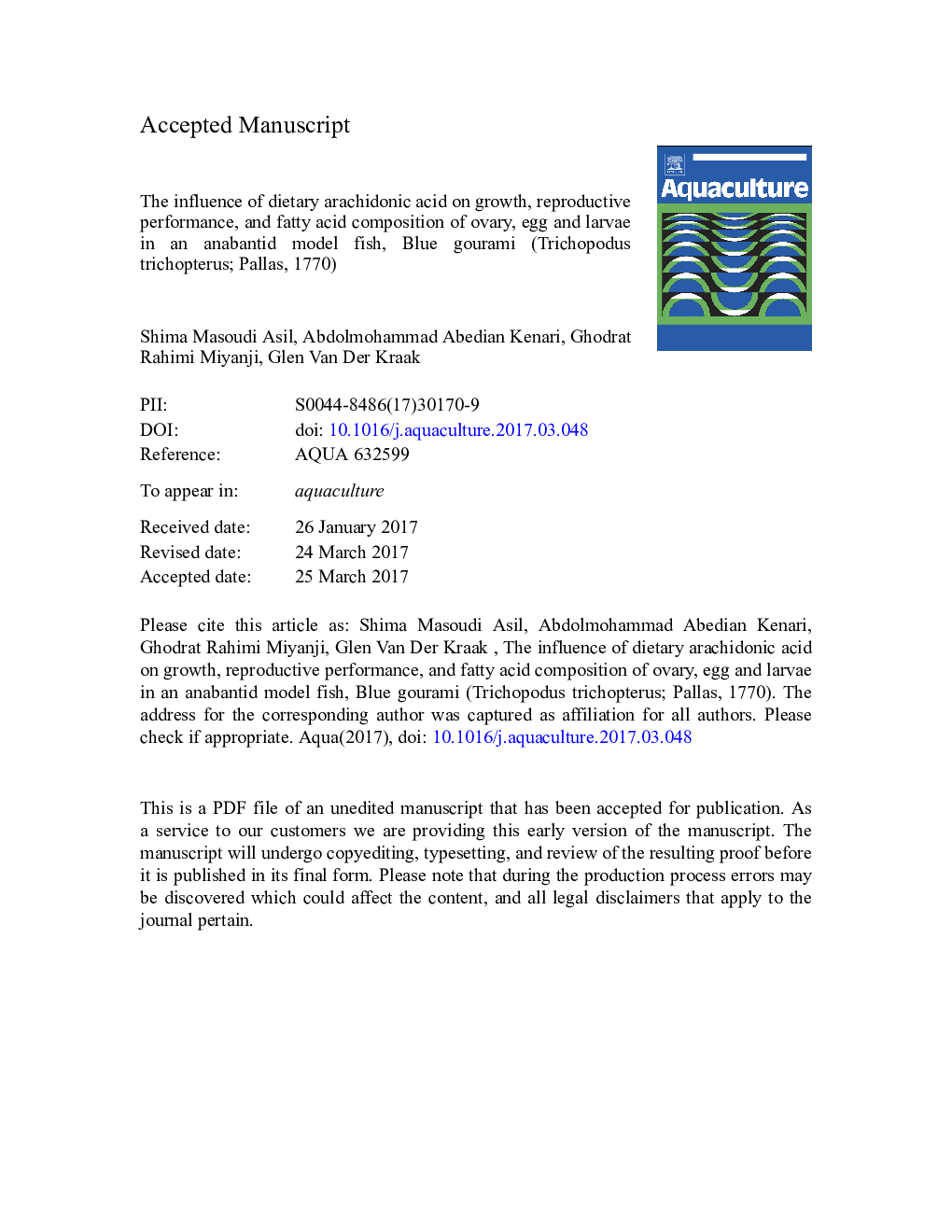| کد مقاله | کد نشریه | سال انتشار | مقاله انگلیسی | نسخه تمام متن |
|---|---|---|---|---|
| 5539407 | 1552812 | 2017 | 47 صفحه PDF | دانلود رایگان |
عنوان انگلیسی مقاله ISI
The influence of dietary arachidonic acid on growth, reproductive performance, and fatty acid composition of ovary, egg and larvae in an anabantid model fish, Blue gourami (Trichopodus trichopterus; Pallas, 1770)
دانلود مقاله + سفارش ترجمه
دانلود مقاله ISI انگلیسی
رایگان برای ایرانیان
کلمات کلیدی
EFAFBWSGRFCRTFALNAHSIFFADMRTIBWHUFABHTLC-PUFADPHBF3GSIEPAsum of saturated fatty acidsOne-way ANOVA - ANOVA یک طرفهArachidonic acid - اسید آراشیدونیکEicosapentaenoic acid - اسید ایکوزاپنتانوئیکdocosahexaenoic acid - اسید داکوزاگزوائونیکLinoleic acid - اسید لینولئیکalpha linolenic acid - اسید لینولنیک آلفاEssential fatty acid - اسید چرب ضروریFree fatty acids - اسیدهای چرب آِزادHighly unsaturated fatty acids - اسیدهای چرب اشباع نشدهLong chain polyunsaturated fatty acids - اسیدهای چرب اشباع نشدهWeight gain - افزایش وزنone-way analysis of variance - تحلیل واریانس یک راههBoron trifluoride - تری فلوراید بورstandard error of the mean - خطای استاندارد میانگینARA - در حال حاضرDHA - دوکوساهگزائنوئیک اسیدdays post hatching - روز پس از اخاذیHepatosomatic index - شاخص Hepatosomaticgonadosomatic index - شاخص گنادوسوماتیکCondition factor - فاکتور وضعیتfatty acid methyl esters - متیل استرهای اسید چربFAME یا fatty acid methyl esters - متیل استرهای اسید چربSEM - مدل معادلات ساختاری / میکروسکوپ الکترونی روبشیspecific growth rate - نرخ رشد خاصfeed conversion ratio - نسبت تبدیل خوراکbutylated hydroxytoluene - هیدروکسی تورولین باتلاقیinitial body weight - وزن اولیه بدنfinal body weight - وزن نهایی بدنGas chromatography - کروماتوگرافی گازیTotal fatty acids - کل اسیدهای چرب
موضوعات مرتبط
علوم زیستی و بیوفناوری
علوم کشاورزی و بیولوژیک
علوم آبزیان
پیش نمایش صفحه اول مقاله

چکیده انگلیسی
This study investigates the influence of arachidonic acid (ARA) on growth, reproductive performance, and fatty acid compositions of ovary, egg and 3-DPH (days post hatching) larvae of Trichopodus trichopterus broodstock. A 150-day feeding experiment was performed comparing the effects of five ARA-supplemented diets containing 0 (control), 0.5, 1, 1.5 and 2% ARA (of total fatty acids) (TFA). Growth parameters including final weight, weight gain and specific growth rate (SGR) did not differ between different groups (P > 0.05). Feed conversion ratio (FCR) was significantly lower in control group compared to 0.5 and 1.5% ARA groups (P < 0.05). Contrary to growth indices, all reproductive traits were significantly affected by ARA contents in diets. Absolute and relative fecundities increased in relation to the ARA content (P < 0.05). The maximum absolute and relative fecundities (13.3 and 974.3 Ã 103, respectively) were recorded in 2% ARA treatment group (P < 0.05). Mean oocyte diameter reached the greatest size (861.66 μm) in 1% ARA and was significantly different than other treatments (P < 0.05). The yolk sac diameter was enhanced linearly by increasing dietary ARA (P < 0.05). Results showed striking effects of dietary ARA on its accumulation in ovaries, eggs and larva. Æ© n â 6 series fatty acid (44.9%) and its constituent (18:2n â 6) (40.85%) reached the highest contents in 0.5% ARA in ovaries (P < 0.05). A similar trend was seen in fertilized eggs and 3-DPH larvae in that the highest amounts of 18:2-6 and Σ n â 6 were found in the 0.5% ARA group (P < 0.05). A second order polynomial regression was employed for estimating ARA/EPA (eicosapentaenoic acid) ratios and showed that the respective ratio enhanced linearly in the ovary and fertilized egg. Correspondingly, ARA/DHA (docosahexaenoic acid) ratio in ovary, fertilized egg and larvae reflected those of the experimental diets. Their fatty acid profiles reflect the diet composition well, ovary (R2 = 0.87), fertilized egg (R2 = 0.91) and 3DPH larvae (R2 = 0.82) and the ARA/DHA ratios were linearly improved by increasing dietary ARA (P < 0.05). Overall, the results of this study revealed the necessity of ARA inclusion in T. trichopterus broodstock diets. This conclusion challenges the generally accepted hypothesis that freshwater fish meet their highly unsaturated fatty acids (HUFA) requirements by elongation and desaturation their precursors. These findings showed that T. trichopterus broodstock, as a model of asynchronous multi-batch spawning fish, needs to receive at least 1% ARA in their maturation diet to improve reproductive performance. The best efficiency was achieved in 2% ARA, based on fecundity, yolk sac diameter and hatching rate.
ناشر
Database: Elsevier - ScienceDirect (ساینس دایرکت)
Journal: Aquaculture - Volume 476, 1 July 2017, Pages 8-18
Journal: Aquaculture - Volume 476, 1 July 2017, Pages 8-18
نویسندگان
Shima Masoudi Asil, Abdolmohammad Abedian Kenari, Ghodrat Rahimi Miyanji, Glen Van Der Kraak,